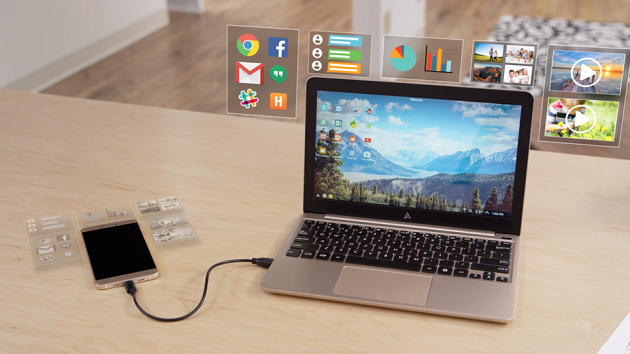This idea of being able to plug one’s smartphone into a laptop shell for the purpose of using the device as a laptop is not a new one – it was actually introduced over five years ago. Since then, there have been numerous iterations of the technology, none of which have proven all that successful.
Since then, there have been numerous iterations of the technology, none of which have proven all that successful.
This track record is what makes the Superbook such a curious story – the product is on Kickstarter and just a few days in to its online funding campaign, has already surpassed its goal of generating $50,000. In fact, at the time this article is being written, it’s closing in on the one million dollar mark — all on the very simple idea that for $99, users can plug their Android (V.5.0 or higher) phone into a laptop shell and instantly enjoy a Chromebook-esque experience.
 Truth be told, though, there’s nothing all that spectacular about the product — it features an 11.6” HD screen, keyboard and trackpad, and eight hours of battery life.
Truth be told, though, there’s nothing all that spectacular about the product — it features an 11.6” HD screen, keyboard and trackpad, and eight hours of battery life.
Even the price — at $99, the Superbook is approximately $50 cheaper than an actual Chromebook, which comes with far better specs. The company tries to turn this point around on its campaign page by pointing out most users update their smartphones every one to two years. So, each time he / she gets a new phone with better processing power, their laptop’s processing power will improve too; thus negating the need to ever purchase a new laptop.
Another selling point that the Superbook team and other companies in the past have made is data synching. The pitch here is that since everything is stored on the smartphone, when it gets plugged into the laptop shell, there’s no need to sync the data up between the two devices.
Quite frankly, I find this point debatable, what with the proliferation and success of cloud storage options like Google Drive, DropBox, and others, most smartphone users already have an option in place for being able to access their data from any device, and with relative ease.
The best case study to date is the failed launch of Microsoft’s Continuum option, which allows users to plug their Windows 10 Mobile phone into any screen and instantly enjoy a pseudo-desktop PC experience. It’s a neat idea, but there’s been no real buy-in from the public, and the product continues to struggle to take off, despite the popularity and overall favoritism expressed towards Windows OS.
Now, all of this is not to disparage the Superbook product. Based on everything the company has listed on its campaign page, it sounds like it might be a good product. Rather, this is a reflection of the technology as a whole. While it’s being marketed as an alternative to the laptop computer, ultimately the user still has to use two devices. So, there is no lifestyle simplification here, nor has this type of product solved any long-standing issue in the consumer electronics industry; the way I see it, these types of devices are quite simply glorified smartphone accessories.
Advertisement
Learn more about Electronic Products Magazine





